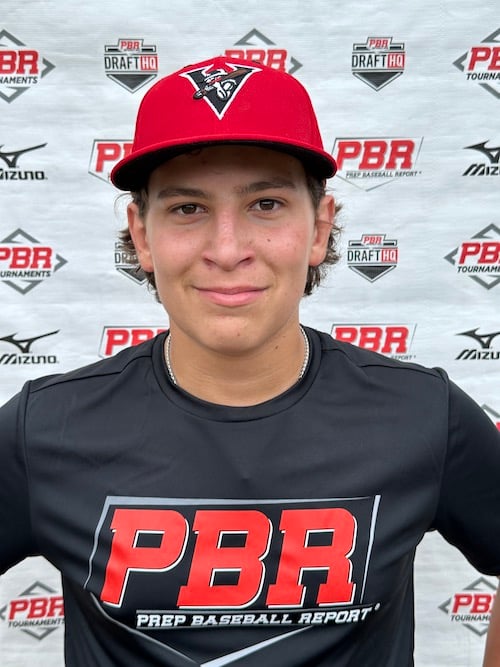Virginia/DC State Games Data Dive: Pitchers
June 27, 2023

Follow @PBRVirginiaDC
Facebook + Instagram
Last week, over 130 players from around Virginia and DC descended upon Fred Nats Stadium for a sold out Summer State Games. We take a look at a few standouts that announced their presence on the mound.
Pitcher Standouts
 |
Ryan DeLashmutt RHP / OF / Frank W. Cox, VA / 2024Being 6'2" and throwing mid-upper 80's is the start of a good recipe for success. He doesn't throw from a high release point which makes him all the more intriguing. There's been a movement throughout college and professional baseball, finding diamonds in the rough of guys with low arm slots, high vertical approach angles (VAA), and high carry fastballs. He meets two of these requirements and can reach the third with some work on his fastball.
The average release height on all three pitches is 5 ft. on the nose. His fastball is operating at 85% spin efficiency at 1:15 tilt, where it is currently entering the dead zone. Suppose he were to adjust his tilt towards 12 o'clock (not necessarily 12 o'clock). In that case, he has the capacity to get up into the 18" of carry from that arm slot, which makes it closer to elite. For reference, he's currently averaging 13.7" IVB and 10.7" HB. It also helps that he has an average 6'10" extension. The changeup and curveball are both viable options for the time being, but the primary focus of his development needs to be on the potential unicorn fastball. There is a 9 MPH velocity difference between the fastball and changeup and a 12" separation in vertical movement. -Bradley Greenberg (Data Analyst Intern)
|
 |
Caelan Goodwin-Slater RHP / SS / Woodbridge, VA / 2025Another low-arm slot guy with a competitive VAA in the strike zone. However, with Goodwin-Slater, he's operating at 96% spin efficiency and near-perfect fastball shape, given his arm slot. The fastball, on average, has 20.5" IVB and 8.5" HB. Two issues were present when we saw him at the State Games: one he can control right now, and the other he can work towards as his strength and body mature. His fastball velocity range was 81-83, and he used the fastball in the heart and lower portion of the plate. Using high-carry fastballs at the bottom of the zone can be effective for getting called strikes, but become much easier to hit as they carry into the middle of the zone. For Goodwin-Slater, he will generate swings and misses, as well as pop-ups, at the top and slightly above the zone. He's also a guy that can spin the ball decently, averaging 2177 RPMs on the fastball and 2242 on the slider. The slider is a true sweeper, grabbing an inch of carry but -8" of sweep, garnering it an effective weapon against right-handed hitters. Sweepers have the highest platoon splits among MLB and college baseball pitches, with R v R and L v L sweepers being quite effective but opposite-handed sweepers being much less effective. This shouldn't be an issue for Goodwin-Slater when he faces lesser high school hitters, but as he faces higher -Bradley Greenberg (Data Analyst Intern)
|
 |
Jack Graham RHP / The Potomac School, VA / 2024In what was the best pure three-pitch mix showcased at the State Games, Graham featured a fastball (83-87), slider (76-78), and splitter (74-76). With a viable three-pitch mix, Graham can get out righties and lefties. The fastball ranged from 2375-2518 RPMs, operating in the mid-80s. The movement on his fastball varied, perhaps demonstrating an inconsistent release on the pitch. He can have a quality 4-seam and a sinker with a little work. Something that's picked up pretty quickly is there's an incomplete lead-leg block which may be in relation to him falling off towards the first base side of the rubber. His off-speed offerings have distinct identities and movement profiles. The slider is a slurve, with more slider than curve. It averages -3.7" IVB and -8.2" HB with an average of 2766 RPMs. His splitter was his best swing-and-miss pitch. It's unique because it is similar to a forkball, spinning at a maximum of 996 RPMs. There is an obvious vertical separation between his fastball and splitter, with a 10" vertical separation and more horizontal movement. -Bradley Greenberg (Data Analyst Intern)
|
 |
Weston Lillard RHP / Highland , VA / 2025One of the top uncommitted 2025 arms in the state, Lillard features a high-spin, three-pitch mix. From a very low three-quarter-arm slot, Lillard was sitting 86-88 from 2400-2600 RPMs. It falls into the dead zone in its movement, something he may get away with due to his arm slot, but a truer sinker/fastball separation could only benefit the young arm. His maximum carry was 16", and his maximum horizontal break was 17". The average movement was 11.5" IVB and 13.4" HB.The slider would normally be considered a curveball based on the movement, but given the arm slot, it's a slider. The release point on the pitch was consistent, and it spun well (2457-2639 RPMs). The changeup was only thrown once at state games, but there was true vertical separation and velocity difference, creating a pitch that will allow him to compete vs higher-level left-handed hitters.Lillard is already a quality high school arm that can generate swings and misses on the next level. With the right direction and continued work to improve, there's a high ceiling for the righty. -Bradley Greenberg (Data Analyst Intern)
|
 |
Caden Merritt OF / RHP / Gainesville, VA / 2025With the way Merritt angles his body down the mound, he nearly releases perfectly over the top. Since he releases from this angle, he is able to generate high amounts of IVB, maxing out at 25" of carry on a fastball with 90% spin efficiency. The fastball averaged 20.7" of carry and 91% spin efficiency, suggesting more room for movement. The heater is at 12:45 tilt, allowing it to average a 7" horizontal break, preventing it from being completed straight. From his high release point, Merritt can generate a 7'3" extension, allowing his 83-86 play up in speed. His slider and curveball have similar movement profiles, but have a 5 MPH difference. -Bradley Greenberg (Data Analyst Intern)
|

